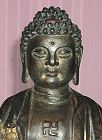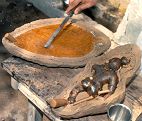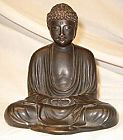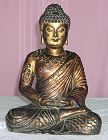
Bronze Sculpture in Asian Art
The Bronze Age in the Near East is considered as beginning around 3300 BC with the increasing use of bronze and the rise of complex urban civilization in the main cultural centers of the region. Metallurgists in Mesopotamia discovered that if they added a small amount of tin ore to the copper ore during smelting, the resulting metal was harder and thus more useful than either tin or copper alone. They had created the alloy bronze.
The ancient skills of bronze casting were almost all but lost, until recent centuries when a revival took place - not a religious revival, but a revival of bronze art - simply for the sake of art. Today, bronze art craftsmanship is practiced throughout Asia from the remote villages of Nepal to little towns like Kumbakonam in South India. Most of these artisans use the technique of bronze casting known as the lost-wax process.
Then, red-hot molten bronze is slowly poured into the mold. At least three days are required for cooling before the mold can be broken and the bronze statue removed. Because every mold is broken at the time of releasing the statue from the mold, each bronze statue created using the lost-wax process is one of a kind.
Bronze is an alloy of copper and tin, typically 60% copper and 40% tin, and is generally harder and more durable than either metal by itself. For this reason, bronze has been used in casting for millennia. A work cast in bronze is sometimes referred to as a bronze. It may also refer to the color of bronze, a moderate yellowish to olive brown. Bronze sculpture should not be confused with similarly named processes - for example, those dubbed 'cold cast bronze' or 'bonded bronze', which is little more than some sort of resin with some metallic content poured into a mold and popped out. These are cheap reproductions and are not bronze at all.
Many of the alloys that are described as bronze are actually brass, which is an alloy of copper and zinc. Bronze statues are often referred to as copper alloy. These may sometimes also be plated with brass or other alloy.
Many Chinese bronzes are adorned on the chest over the heart of Buddha with the WAN symbol, the chinese rendering of the ancient swastika. For a history of this ancient symbol click here.
Closeups of the statues on this page and every sculpture in the Villa Del Prado Light of Asia Collection can be found on the main page. |
 The story of Bronze Statues in Asia begins in what is generally known as the Indus Valley Civilization (2400-B.C.). Most of the bronzes created in Asia throughout the ages have some religious significance - the statues were either for worship in temples or taking on religious processions. With literally hundreds of thousands of temples in Asia, the demand for bronze statues was very great, leading to highly developed skills in bronze casting. Many of these ancient bronze temple statues of Shakyamuni Buddha have found their way to the west over the centuries and are highly prized by collectors.
The story of Bronze Statues in Asia begins in what is generally known as the Indus Valley Civilization (2400-B.C.). Most of the bronzes created in Asia throughout the ages have some religious significance - the statues were either for worship in temples or taking on religious processions. With literally hundreds of thousands of temples in Asia, the demand for bronze statues was very great, leading to highly developed skills in bronze casting. Many of these ancient bronze temple statues of Shakyamuni Buddha have found their way to the west over the centuries and are highly prized by collectors.
 The lost-wax process allows the artisan to achieve the greatest detail in each statue or sculpture. First an exact wax model is prepared in beeswax, allowing the artisan to create very intricate details in the statue. Then the wax is covered in a thick layer of wet clay and allowed to dry very slowly. When almost completely dry the clay is baked in a brick oven. Small openings left in the clay allow the melting wax to escape - leaving behind a detailed mold in clay. The original wax statue is lost and thus the name '
The lost-wax process allows the artisan to achieve the greatest detail in each statue or sculpture. First an exact wax model is prepared in beeswax, allowing the artisan to create very intricate details in the statue. Then the wax is covered in a thick layer of wet clay and allowed to dry very slowly. When almost completely dry the clay is baked in a brick oven. Small openings left in the clay allow the melting wax to escape - leaving behind a detailed mold in clay. The original wax statue is lost and thus the name ' In the final stage of bronze casting the artisan carves away at the statue with hammer and special chisels‚ etching out the last fine details. When the bronze statue is completed it literally shines like gold and as time goes by the statue takes on a duller copper or brass look and green oxides begin to form in the cracks and crevasses. This oxidation process is natural and is caused by the bronze mixing with the elements in the air - the oxidizing itself is considered to enhance the artistic beauty of the statue and it is preferred among lovers of bronze art.
In the final stage of bronze casting the artisan carves away at the statue with hammer and special chisels‚ etching out the last fine details. When the bronze statue is completed it literally shines like gold and as time goes by the statue takes on a duller copper or brass look and green oxides begin to form in the cracks and crevasses. This oxidation process is natural and is caused by the bronze mixing with the elements in the air - the oxidizing itself is considered to enhance the artistic beauty of the statue and it is preferred among lovers of bronze art.
 Bronze statues may be solid, like the one above right, though more often they are hollow core. Bronze may be natural finish which oxidizes with time to a rich patina, or it may be gilt, painted or clad with other metals, including silver and gold.
Bronze statues may be solid, like the one above right, though more often they are hollow core. Bronze may be natural finish which oxidizes with time to a rich patina, or it may be gilt, painted or clad with other metals, including silver and gold.
